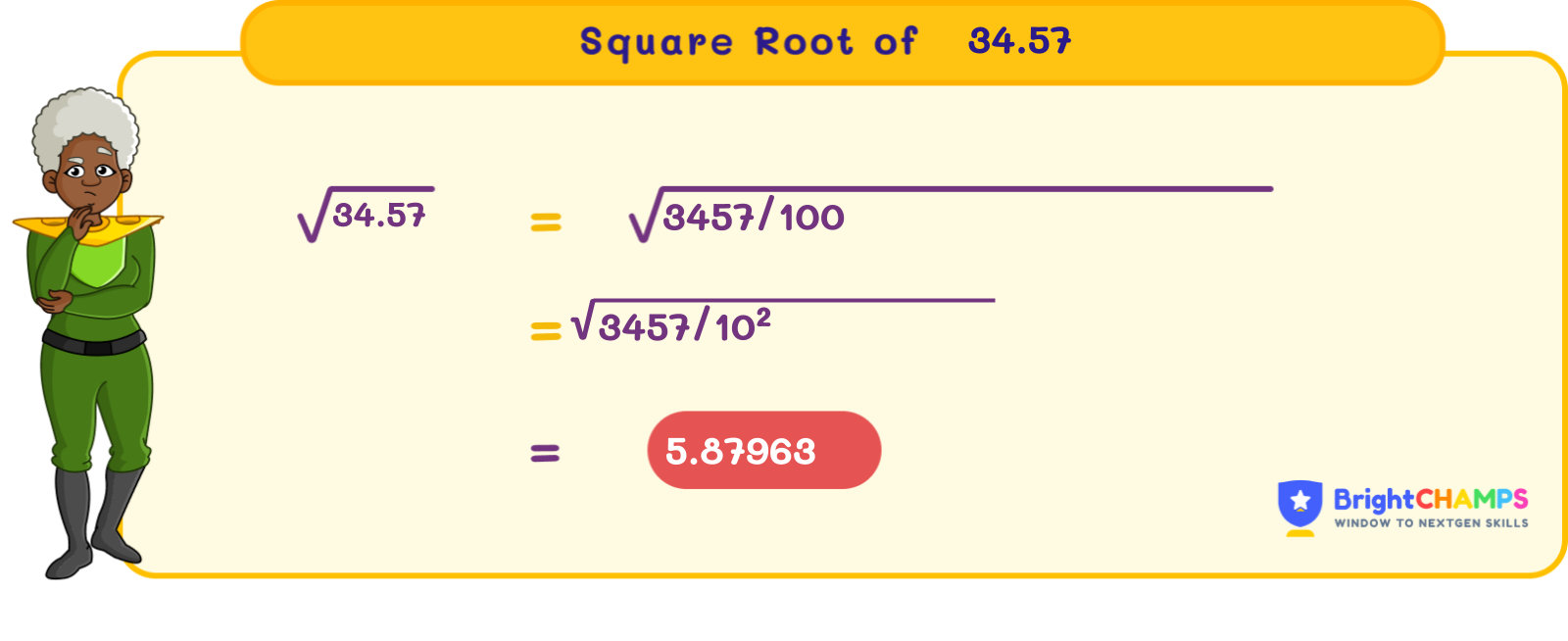![]() Table Of Contents
Table Of Contents

 100 Learners
100 LearnersLast updated on April 8th, 2025

Square Root of 34.57

If a number is multiplied by the same number, the result is a square. The inverse of the square is a square root. The square root is used in fields like vehicle design, finance, etc. Here, we will discuss the square root of 34.57.
What is the Square Root of 34.57?
The square root is the inverse of the square of the number. 34.57 is not a perfect square. The square root of 34.57 is expressed in both radical and exponential form. In the radical form, it is expressed as √34.57, whereas (34.57)^(1/2) in the exponential form. √34.57 ≈ 5.879, which is an irrational number because it cannot be expressed in the form of p/q, where p and q are integers and q ≠ 0.
Finding the Square Root of 34.57
The prime factorization method is used for perfect square numbers. However, for non-perfect square numbers like 34.57, the long-division method and approximation method are used. Let us now learn the following methods:
- Long division method
- Approximation method
Square Root of 34.57 by Long Division Method
The long division method is particularly used for non-perfect square numbers. In this method, we should check the closest perfect square number for the given number. Let us now learn how to find the square root using the long division method, step by step.
Step 1: To begin with, group the numbers from right to left. In the case of 34.57, consider it as 34 and 57.
Step 2: Find n whose square is less than or equal to 34. We can say n is 5 because 5 × 5 = 25, which is less than 34. Now the quotient is 5, and after subtracting 25 from 34, the remainder is 9.
Step 3: Bring down 57, making it the new dividend 957. Add the old divisor with the same number: 5 + 5 = 10, which will be our new divisor.
Step 4: The new divisor will be 10n. We need to find the value of n such that 10n × n is less than or equal to 957. Let n be 9, so 109 × 9 = 981. Since 981 is greater than 957, try n = 8, making 108 × 8 = 864.
Step 5: Subtract 864 from 957; the difference is 93, and the quotient is 5.8.
Step 6: Since the dividend is less than the divisor, add a decimal point, allowing us to add two zeroes to the dividend. The new dividend is 9300.
Step 7: Find the new divisor. 108n becomes 1088, and n is 8 because 1088 × 8 = 8704.
Step 8: Subtracting 8704 from 9300 gives the result of 596.
Step 9: Continue doing these steps until you get two numbers after the decimal point.
So the square root of √34.57 is approximately 5.879.
Square Root of 34.57 by Approximation Method
The approximation method is another approach for finding square roots. It is an easy method to find the square root of a given number. Now, let us learn how to find the square root of 34.57 using the approximation method.
Step 1: Find the closest perfect square of √34.57.
The smallest perfect square less than 34.57 is 25, and the largest perfect square greater than 34.57 is 36.
√34.57 falls between 5 and 6.
Step 2: Apply the interpolation formula:
(Given number - smallest perfect square) / (Greater perfect square - smallest perfect square).
Using the formula (34.57 - 25) / (36 - 25) = 0.8709.
Adding this to the smaller square root, we get 5 + 0.8709 ≈ 5.871.
Thus, the square root of 34.57 is approximately 5.871.

Common Mistakes and How to Avoid Them in the Square Root of 34.57

Square Root of 34.57 Examples

Problem 1
Can you help Max find the area of a square box if its side length is given as √34?

Explanation

Problem 2
A square-shaped building measuring 34.57 square feet is built. If each side is √34.57, what will be the square feet of half of the building?

Explanation

Problem 3
Calculate √34.57 × 5.

Explanation

Problem 4
What will be the square root of (30 + 4.57)?

Explanation

Problem 5
Find the perimeter of a rectangle if its length 'l' is √34.57 units and the width 'w' is 10 units.

Explanation


FAQ on Square Root of 34.57
1.What is √34.57 in its simplest form?
2.Mention the factors of 34.57.
3.Calculate the square of 34.57.
4.Is 34.57 a prime number?
5.Is 34.57 divisible by any integers?
Important Glossaries for the Square Root of 34.57
- Square root: A square root is the inverse of a square. Example: 4² = 16, and the inverse of the square is the square root, which is √16 = 4.
- Irrational number: An irrational number is a number that cannot be written in the form p/q, where q is not equal to zero and p and q are integers.
- Decimal: A decimal is a number that includes a whole number and a fraction represented together. For example, 7.86, 8.65, and 9.42 are decimals.
- Long division method: A technique used to find the square root of non-perfect squares by dividing the digits of the number step by step.
- Approximation: A method of finding an estimated value close to the actual value, often used to find the square root of numbers that are not perfect squares.
Explore More algebra
 Previous to Square Root of 34.57
Previous to Square Root of 34.57


Jaskaran Singh Saluja
About the Author
Jaskaran Singh Saluja is a math wizard with nearly three years of experience as a math teacher. His expertise is in algebra, so he can make algebra classes interesting by turning tricky equations into simple puzzles.

Fun Fact
: He loves to play the quiz with kids through algebra to make kids love it.




